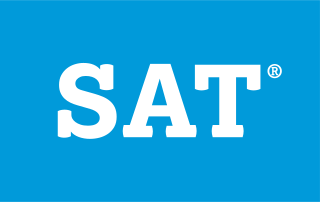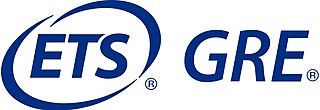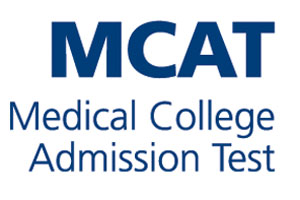The GRE physics test is an examination administered by the Educational Testing Service (ETS). The test attempts to determine the extent of the examinees' understanding of fundamental principles of physics and their ability to apply them to problem solving. Many graduate schools require applicants to take the exam and base admission decisions in part on the results.

The ACT is a standardized test used for college admissions in the United States. It is currently administered by ACT, a nonprofit organization of the same name. The ACT test covers four academic skill areas: English, mathematics, reading, and scientific reasoning. It also offers an optional direct writing test. It is accepted by all four-year colleges and universities in the United States as well as more than 225 universities outside of the U.S.

The SAT is a standardized test widely used for college admissions in the United States. Since its debut in 1926, its name and scoring have changed several times. For much of its history, it was called the Scholastic Aptitude Test and had two components, Verbal and Mathematical, each of which was scored on a range from 200 to 800. Later it was called the Scholastic Assessment Test, then the SAT I: Reasoning Test, then the SAT Reasoning Test, then simply the SAT.

The Graduate Management Admission Test is a computer adaptive test (CAT) intended to assess certain analytical, writing, quantitative, verbal, and reading skills in written English for use in admission to a graduate management program, such as a Master of Business Administration (MBA) program. Answering the test questions requires knowledge of English grammatical rules, reading comprehension, and mathematical skills such as arithmetic, algebra, and geometry. The Graduate Management Admission Council (GMAC) owns and operates the test, and states that the GMAT assesses analytical writing and problem-solving abilities while also addressing data sufficiency, logic, and critical reasoning skills that it believes to be vital to real-world business and management success. It can be taken up to five times a year but no more than eight times total. Attempts must be at least 16 days apart.

Advanced Placement (AP) is a program in the United States and Canada created by the College Board. AP offers undergraduate university-level curricula and examinations to high school students. Colleges and universities in the US and elsewhere may grant placement and course credit to students who obtain qualifying scores on the examinations. The AP curriculum for each of the various subjects is created for the College Board by a panel of experts and college-level educators in that academic discipline. For a high school course to have the designation, the course must be audited by the College Board to ascertain that it satisfies the AP curriculum as specified in the Board's Course and Examination Description (CED). If the course is approved, the school may use the AP designation and the course will be publicly listed on the AP Course Ledger.

The Graduate Record Examinations (GRE) is a standardized test that is an admissions requirement for many graduate schools in the United States and Canada and a few other countries. The GRE is owned and administered by Educational Testing Service (ETS). The test was established in 1936 by the Carnegie Foundation for the Advancement of Teaching.
The Fundamentals of Engineering (FE) exam, also referred to as the Engineer in Training (EIT) exam, and formerly in some states as the Engineering Intern (EI) exam, is the first of two examinations that engineers must pass in order to be licensed as a Professional Engineer (PE) in the United States. The second exam is the Principles and Practice of Engineering exam. The FE exam is open to anyone with a degree in engineering or a related field, or currently enrolled in the last year of an Accreditation Board for Engineering and Technology (ABET) accredited engineering degree program. Some state licensure boards permit students to take it prior to their final year, and numerous states allow those who have never attended an approved program to take the exam if they have a state-determined number of years of work experience in engineering. Some states allow those with ABET-accredited "Engineering Technology" or "ETAC" degrees to take the examination. The exam is administered by the National Council of Examiners for Engineering and Surveying (NCEES).

The Law School Admission Test is a standardized test administered by the Law School Admission Council (LSAC) for prospective law school candidates. It is designed to assess reading comprehension, analytical reasoning, and logical reasoning. The test is an integral part of the law school admission process in the United States, Canada, the University of Melbourne, Australia, and a growing number of other countries.
The Miller Analogies Test (MAT) is a standardized test used both for graduate school admissions in the United States and entrance to high I.Q. societies. Created and still published by Harcourt Assessment, the MAT consists of 120 questions in 60 minutes. Unlike other graduate school admissions exams such as the GRE, the Miller Analogies Test is verbal or computer based.
The GRE subject test in mathematics is a standardized test in the United States created by the Educational Testing Service (ETS), and is designed to assess a candidate's potential for graduate or post-graduate study in the field of mathematics. It contains questions from many fields of mathematics; about 50% of the questions come from calculus, 25% come from algebra, and 25% come from a broad variety of other topics typically encountered in undergraduate mathematics courses, such as point-set topology, probability and statistics, geometry, and real analysis.
The Dental Admission Test is a multiple-choice standardized exam taken by potential dental school students in the United States and Canada. The DAT is a computer based test that can be administered almost any day of the year. Tests are taken at Prometric testing centers throughout the United States after the preliminary application through the American Dental Association is completed. Each applicant may only take the test a total of three times before having to ask special permission to take the exam again. After taking the exam, applicants must wait 90 days before repeating it. Each exam costs $495, all of which is non-refundable.
The GRE Literature in English Test was a standardized test administered by the Educational Testing Service. It was intended to evaluate applicants seeking admission to a graduate program in English Studies. The test surveyed a wide range of topics related to literature in English, but the focus was mainly on works long accepted as part of the canon.
GRE Subject Biochemistry, Cell and Molecular Biology was a standardized exam provided by ETS that was discontinued in December 2016. It is a paper-based exam and there are no computer-based versions of it. ETS places this exam three times per year: once in April, once in October and once in November. Some graduate programs in the United States recommend taking this exam, while others require this exam score as a part of the application to their graduate programs. ETS sends a bulletin with a sample practice test to each candidate after registration for the exam. There are 180 questions within the biochemistry subject test.
The SAT Subject Test in Chemistry was a one-hour multiple choice test given on chemistry by The College Board. A student chose whether to take the test depending upon college entrance requirements for the schools in which the student was planning to apply. Until 1994, the SAT Subject Tests were known as Achievement Tests; until January 2005, they were known as SAT 2s; they are still well known by the latter name. On January 19 2021, the College Board discontinued all SAT Subject tests, including the SAT Subject Test in Chemistry. This was effective immediately in the United States, and the tests were to be phased out by the following summer for international students. This was done as a response to changes in college admissions due to the impact of the COVID-19 pandemic on education.

The ICFESexamination, or Saber 11, is a high school exit examination administered annually in grade 11 in Colombian high schools. The exam is standardized, similar to the SAT and ACT examinations taken by high school students in the United States. The purpose of the exam is to evaluate students' aptitude in five subjects: critical reading, mathematics, social studies, science, and English. Each exam question has four multiple-choice answers, except for the English section which provides between three and eight possible answers for each question.
The GRE Psychology subject test is a standardized test used in admission decisions by some graduate programs in psychology in several English-speaking countries, especially in the United States.
The Optometry Admission Test (OAT) is a test used to determine applicants' qualification for admission to a school of optometry. All colleges of optometry in the United States and the University of Waterloo in Canada use scores from the exam, in addition to work done at the undergraduate level of study, to decide whether to accept candidates. The test is administered by the American Dental Association (ADA) on behalf of the Association of Schools and Colleges of Optometry (ASCO).

The Medical College Admission Test is a computer-based standardized examination for prospective medical students in the United States, Australia, Canada, and the Caribbean Islands. It is designed to assess problem solving, critical thinking, written analysis and knowledge of scientific concepts and principles. Before 2007, the exam was a paper-and-pencil test; since 2007, all administrations of the exam have been computer-based.
The GRE subject test in biology was a standardized test in the United States created by the Educational Testing Service, and is designed to assess a candidate's potential for graduate or post-graduate study in the field of biology. The test is comprehensive and covers—in equal proportions—molecular biology, organismal biology, and ecology and evolution.
The Major Field Test for Master of Business Administration (MFT-MBA) is a national standardized exam administered in the United States at the end of MBA programs. It is a comprehensive exit exam. The MFT-MBA aims to assess skills, knowledge, and reasoning ability within the domain of standard MBA curriculum. It is administered by Educational Testing Service (ETS) and has been used in the MBA programs of over 300 U.S. universities.








